
|
Battle of the Atlantic
Prelude to War
Germany was the first nation to effectively use the submarine in an attrition war. During the First World War, German submarines sank over 11 million tons of allied shipping, nearly cutting off the Atlantic line and starving Britain to submission. Great Britain as an island depended on the sea to bring in supplies of food, fuel and raw materials. The u-boats objective was not to sink ships, it was to starve Britain. Every ship sunk was a loss to a nation depending on the sea – eroding with it her ability to continue fighting.
At the end of the war, the Treaty of Versailles, which formalized the surrender of the German Armed forces, forbade Germany from building or operating a submarine fleet. From 1919 until 1935, Germany had disguised its submarine program under various non-military projects. Nevertheless, behind this shroud of secrecy, German U-boat staff continued to develop new theories, strategies and equipment to successfully wage a future commerce war.
| At the pinnacle of the U-boat force was Admiral Karl Donitz, an expert naval strategist and a brilliant U-boat tactician. Donitz had served as a U-boat captain during the First World War. In 1935, after Hitler denounced the Versailles Treaty and unveiled the existence of a new U-boat force, Donitz was appointed as the commander-in-chief of BdU (Befehlshaber der U-boote). Under his leadership, the U-boat force would soon play the major role it did in the Battle of the Atlantic. |
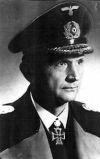
|
First, BdU had looked at the commerce war in its entirety and theorized on how much tonnage was needed to be sunk in order to seriously affect the British economy. By calculating average tonnage sunk per day, BdU could measure sinking efficiency and the effectiveness of a campaign. This information provided vital clues as to when the focus of a campaign should be shifted. Additionally, using the same tonnage efficiency, crew performance could be evaluated and weaknesses in training identified. Strengths and weaknesses of the operational tactics could also be earmarked for improvement.
Second, they devised new tactics and strategies to defeat the convoy system. Here the work of Karl Donitz would lead to the most famous war doctrine of the Battle of the Atlantic, the Wolf Pack or Rudeltaktik as the Germans called it. This tactic called for delaying an attack on a convoy until sufficient U-boats could be in position to make a massed organized attack. This had devastating results as the escort screens were overwhelmed by the sheer surprise and number of attacking U-boats. The theoretical elements would require a U-boat upon sighting of a convoy to radio BdU. The U-boat (also known as the shadower) will remain just out of the detection range of the convoy and continue to shadow it while BdU coordinates an attack. When all U-boats are in position, the attack commences, usually at night. Donitz’s other u-boat doctrine included the coordination of reconnaissance aircraft, supply vessels and night surface attack allowed his boats to strike without warning, where they were most effective and least expected.
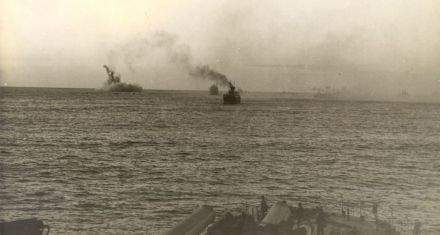
|
| Convoy under wolf pack attack. Photographed aboard USS York, the freighter Hugh L. Scott takes a torpedo hit from U-130 and goes down. At least three freighters and a destroyer were sunk during this attack. Fedala Bay, Morocco (North Africa), Nov 12, 1942. |
BdU knew that superior tactics and strategies alone would not win the war. For that, they needed men and new submarines and submarine equipment to put those strategies into practice. BdU was very definite about the desirable performance characteristics of the Atlantic going U-boat they wanted. Surface speed, maneuverability and torpedo capacity were the most important offensive characteristics. Since submerging was considered as the primary escape method, dive speed and depth were considered as the most important defensive characteristics. The U-boat force understood that given the limited underwater capabilities of the U-boat, it was not to be considered as a true submarine. Rather, it was considered as a torpedo boat, with the special capability to submerge for attack or defense. Thus a U-boat was short for Unterseeboot, or underwater boat. With the advancement of technology, particularly in the field of electronic and optical advancement, this had allowed German engineers (and otherwise) to design far more effective U-boats than the U-boats of the First World War era.
After the theoretical elements and desired characteristics were worked out, Germany needed a way to build and train a U-boat force. Unfortunately for the German Navy, the Treaty of Versailles forbade Germany from building and operating a U-boat force. In order to research and develop U-boat tactics, Germany disguised its submarine program under the cover of an “Anti-Submarine Warfare School”. The function of this school was to study submarine operations and deployment tactics – and to develop counter measures which could be used against submarines. This was the pretext, but in reality, this organization served as training grounds for submarine crew and developed tactics in which U-boats could use in a future shipping war.
For the technological expertise and actual building of the U-boats itself, Germany used many foreign firms to aid in the design, development and construction of U-boats. These foreign firms, namely in the Netherlands specialized in building submarines and sold them to other nations – most notably Spain, Finland and Turkey. Submarine parts would be fabricated by many independent firms, and brought together for final assembly at the dockyard. The German Navy financed and directed these projects and acted as independent business entities on their own. The expertise of the Atlantic U-boats were largely due to the experience and expertise gained while building submarines for other nations.
1935 marked another turning point for the German Navy. On February 1st 1935, Hitler unveiled the existence of a new U-boat force and on March 16, repudiated the terms of the Versailles Treaty. It was also at this time that the Kriegsmarine (Combat Navy) and Unterseebootwaffe (U-boat arm) was officially formed. Unknown to other nations at that time, Germany had already begun construction for 12 new U-boats as early as 1934 – by January 1935, the parts were awaiting assembly in Kiel and construction began to be undertaken openly. On 15th June 1935, the first Type IIA coastal U-boat U-1 was launched.

|
| U-1, the first Type IIA u-boat, soon after being commissioned in 1935. These early u-boats had serrated net cutters at the bow. |
By June 1935, the Anglo-German Naval Agreement was signed, which allowed the Kriegsmarine to legally construct up to 35 percent tonnage of the British Navy. Submarine tonnage allowed was up to 45 percent and could be raised up to 100 percent with due notification. September saw the establishment of the “Weddigen” Flotilla in Kiel, the first U-boat base - fully equipped with three Type IIB U-boats. Finally, the Commander-in-Chief of the Kriegsmarine, Admiral Raeder, appointed Karl Donitz as commander of the new U-boat force. This turning point marked the beginning of the history of the U-boat force.
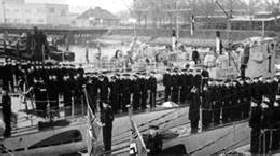
|
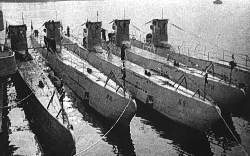
|
| Commissioning ceremony of the 1st Wediggen Flotilla. November 7, 1935. | Five u-boats of the 1st Weddigen Flotilla in anchor. Kiel, January 1936. |
Donitz understood the potential and tactical capabilities of u-boats and believed Germany could fight a great naval power like Britain. The Royal Navy was the world’s most powerful fleet, consisting of many of battleships and cruisers. He envisioned that the Royal Navy was outmoded with “big gun” capital ships and would not be able to deal with the tactics of modern submarine warfare. He correctly predicted that the British had placed too much faith in ASDIC (sonar). Donitz also knew that superior tactics alone will not win the war. For that, he needed a force of at least 300 u-boats to successfully blockade Britain.
Unfortunately for the U-boat force, as with all other naval officers at that time, the German Naval High Command believed vehemently in the unsinkable battleship. They wanted a powerful surface fleet which could protect Germany in future conflicts, and also equally important, was for national pride. A nation had to have one of these to be considered a “superpower”. From 1935 up to the outbreak of war in 1939, the German High Command being in firm control of the naval construction budget had emphasized construction on capital ships with the priority for u-boats well below those for battleships and cruisers. Donitz was a well regarded officer, but he was just a commodore (one star officer) and his views were given the same weight as his rank.
This was a fatal mistake for Germany. As we would learn later, Donitz’s U-boats were highly successful upon the opening of the war, and at one point had nearly won the war for Germany; while on the other hand, the big battleships of Bismarck and Graf Spee only made headlines as being hunted and sunk by the Royal Navy.
The other point of difference between the U-boat force and the Naval High Command was on the u-boat types to be constructed. Donitz wanted medium sized boats, with good surface speed and quick diving speeds. These performance characteristics would allow him to implement the Wolf Pack tactics he had envisioned. Additionally, with the limited construction budget, smaller boats would mean more could be built in a shorter amount of time. The Naval High Command on the other hand wanted larger sea going boats, with long ranges and higher torpedo loads - so they could remain longer in their patrol zones.
All of this had meant that the U-boat force would have far fewer and less effective u-boats than it knew was necessary to sink the kind of tonnage it was tasked to do. When war broke out in September 1939, Donitz had only 57 operational u-boats, or 1/6th of the number of boats he wanted. Of these, only 38 were capable of operations in the Atlantic.
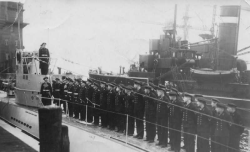
|
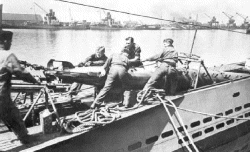
|
| Commissioning ceremony of the 2nd u-boat flotilla Saltzwedel, Bremen 1936. With the fall of france in June 1940, this flotilla was moved to Lorient, France. | Torpedoes weighed 1 ton and required many men and winches to hoist and load the torpedoes. Depending on crew experience, it takes between 15 to 30 minutes to load one tube. |



